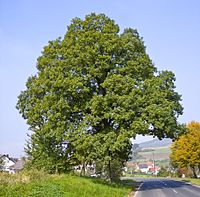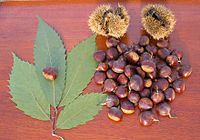
Enhanced hypovirus transmission by engineered super donor strains of the chestnut blight fungus, Cryphonectria parasitica, into a natural population of strains exhibiting diverse vegetative compatibility genotypes.
Sign Up to like & getrecommendations! Published in 2019 at "Virology"
DOI: 10.1016/j.virol.2018.12.007
Abstract: Horizontal transmission of virulence attenuating hypoviruses of Cryphonectria parasitica is restricted by an allorecognition system termed vegetative incompatibility (vic). A super donor formulation of two engineered C. parasitica strains (SD328/SD82) with gene disruptions at four… read more here.
Keywords: super donor; transmission; enhanced hypovirus; formulation ... See more keywords

Cryphonectria parasitica, the causal agent of chestnut blight: invasion history, population biology and disease control.
Sign Up to like & getrecommendations! Published in 2018 at "Molecular plant pathology"
DOI: 10.1111/mpp.12542
Abstract: Chestnut blight, caused by Cryphonectria parasitica, is a devastating disease infecting American and European chestnut trees. The pathogen is native to East Asia and was spread to other continents via infected chestnut plants. This review… read more here.
Keywords: chestnut; control; disease; biology ... See more keywords

Multilocus PCR assay reveals high diversity of vegetative compatibility types in populations of Cryphonectria parasitica in Croatia
Sign Up to like & getrecommendations! Published in 2018 at "Plant Pathology"
DOI: 10.1111/ppa.12751
Abstract: The ascomycete fungus Cryphonectria parasitica, causal agent of chestnut blight, is probably one of the best known invasive fungal pathogens in forests of Europe and North America. Mycovirus that reduces virulence of C. parasitica can… read more here.
Keywords: vegetative compatibility; diversity; parasitica croatia; pcr assay ... See more keywords

In-Tree Behavior of Diverse Viruses Harbored in the Chestnut Blight Fungus, Cryphonectria parasitica
Sign Up to like & getrecommendations! Published in 2020 at "Journal of Virology"
DOI: 10.1128/jvi.01962-20
Abstract: The ascomycete Cryphonectria parasitica causes destructive chestnut blight, which is controllable by hypovirulence-conferring viruses infecting the fungus. The tripartite chestnut/C. parasitica/virus pathosystem involves the dynamic interactions of their genetic elements, i.e., virus transmission and lateral… read more here.
Keywords: chestnut blight; chestnut; hypovirulence; cryphonectria parasitica ... See more keywords

Biological Control of Cryphonectria parasitica in Romanian Protected Sweet Chestnut Forests
Sign Up to like & getrecommendations! Published in 2017 at "Notulae Botanicae Horti Agrobotanici Cluj-napoca"
DOI: 10.15835/nbha45210895
Abstract: Asiatic fungus Cryphonectria parasitica has gradually infected all chestnut habitats, forest and horticulture plantations from the most important natural centres of sweet chestnut distribution in Romania. The objectives of this work were to understand the… read more here.
Keywords: chestnut; control; biological control; cryphonectria parasitica ... See more keywords

New finds of Cryphonectria parasitica and the first record of chestnut blight on red oak Quercus rubra L. in the Czech Republic.
Sign Up to like & getrecommendations! Published in 2018 at "Journal of forest science"
DOI: 10.17221/4561-jfs
Abstract: The causal agent of the chestnut blight, the fungus Cryphonectria parasitica (Murrill) M. E. Barr (syn. Endothia parasitica (Murrill) P. J. Anderson et H. W. Anderson), was found out at new localities in the Czech… read more here.
Keywords: oak quercus; red oak; czech republic; chestnut blight ... See more keywords

Laccase Activity in Fungus Cryphonectria parasitica Is Affected by Growth Conditions and Fungal–Viral Genotypic Interactions
Sign Up to like & getrecommendations! Published in 2021 at "Journal of Fungi"
DOI: 10.3390/jof7110958
Abstract: Laccase activity reduction in the chestnut blight fungus Cryphonectria parasitica usually accompanies the hypovirulence caused by the infection of fungus with Cryphonectria hypovirus 1 (CHV1). However, the different methods utilized for assessing this phenomenon has… read more here.
Keywords: growth conditions; activity; fungus cryphonectria; cryphonectria parasitica ... See more keywords

Temperature Effects on the Cryphonectria hypovirus 1 Accumulation and Recovery within Its Fungal Host, the Chestnut Blight Pathogen Cryphonectria parasitica
Sign Up to like & getrecommendations! Published in 2023 at "Viruses"
DOI: 10.3390/v15061260
Abstract: Biological control of Cryphonectria parasitica fungus, the causal agent of chestnut blight, by virus infection (hypovirulence) is an effective control strategy against chestnut blight in Europe and some parts of North America. The most studied… read more here.
Keywords: temperature; cryphonectria parasitica; chestnut blight; cryphonectria hypovirus ... See more keywords